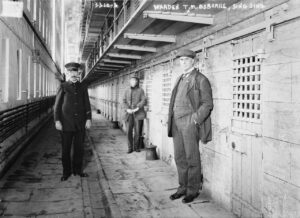 The Crime Museum’s collection once held a cell lock from New York’s Sing Sing prison (built 1825) so rusted and discolored from age that it looks like somebody buried it. In fact, one of the penologists of the era declared that in order for the inmates to fully confront and repent their criminal pasts, they had “to be literally buried from the world”. Penological thought at the time believed that there was a very strong connection between a prison’s architecture, the forced social isolation of convicts, and the ability of the inmate to truly reform and to try to rebuild his shattered life. For these reasons, Captain Elam Lynds, the warden of New York’s Auburn Prison and the first warden of Sing Sing, directed the first 100 Sing Sing inmates to build the edifices from marble stones quarried nearby. The resulting complex was as quiet as a stone tomb. Interestingly, the name Sing Sing was taken from the name of the local village. The village of Sing Sing was named after the local Indian tribe’s words “sint sinks” or “stone upon stone.” The prison followed the Auburn Prison policy of silence, which forbade inmates from making any unnecessary noises whatsoever. Inmates could neither speak to each other, nor, ironically, could they sing. They could not engage in any disruptive behavior contrary to the regulations of the “silent system”, which sought to improve their morals during their incarceration. As a result, Sing Sing became “one of the most repressive institutions in America.”
The Crime Museum’s collection once held a cell lock from New York’s Sing Sing prison (built 1825) so rusted and discolored from age that it looks like somebody buried it. In fact, one of the penologists of the era declared that in order for the inmates to fully confront and repent their criminal pasts, they had “to be literally buried from the world”. Penological thought at the time believed that there was a very strong connection between a prison’s architecture, the forced social isolation of convicts, and the ability of the inmate to truly reform and to try to rebuild his shattered life. For these reasons, Captain Elam Lynds, the warden of New York’s Auburn Prison and the first warden of Sing Sing, directed the first 100 Sing Sing inmates to build the edifices from marble stones quarried nearby. The resulting complex was as quiet as a stone tomb. Interestingly, the name Sing Sing was taken from the name of the local village. The village of Sing Sing was named after the local Indian tribe’s words “sint sinks” or “stone upon stone.” The prison followed the Auburn Prison policy of silence, which forbade inmates from making any unnecessary noises whatsoever. Inmates could neither speak to each other, nor, ironically, could they sing. They could not engage in any disruptive behavior contrary to the regulations of the “silent system”, which sought to improve their morals during their incarceration. As a result, Sing Sing became “one of the most repressive institutions in America.”
It also became one of the most famous prisons. The notorious bank robber, Willie Sutton, served time in (and later escaped from) Sing Sing, and Julius and Ethel Rosenberg, the infamous Communist spies, died in the electric chair there. Hollywood gangster films often feature Sing Sing in their resolutions, for example noted screen gangster James Cagney ended up there after being dispatched “up the river” by law-enforcement authorities. Despite its iconic and chilling reputation as an ominous warehouse for society’s worst criminals, recently there was an attempt to close the doors of Sing Sing forever. Several state and local lawmakers, together with thousands of residents from the nearby village, now know as Ossining, asked New York Governor Andrew Cuomo to close the maximum-security facility and to relocate the 1,725 current inmates to a new or refurbished prison elsewhere in the state. They had hoped to convert Sing Sing’s 60-acre riverside campus into an area of shops and condominiums, which might have elevated property values and generated more taxes for the cash-strapped local government. The site has been described as “beautiful” with “phenomenal views” that offer spectacular sunsets. Cuomo indicated, however, that he would not close any maximum-security prisons that housed dangerous murderers and rapists and others who had been convicted of major crimes.
Back to Crime Library
|
|
|
